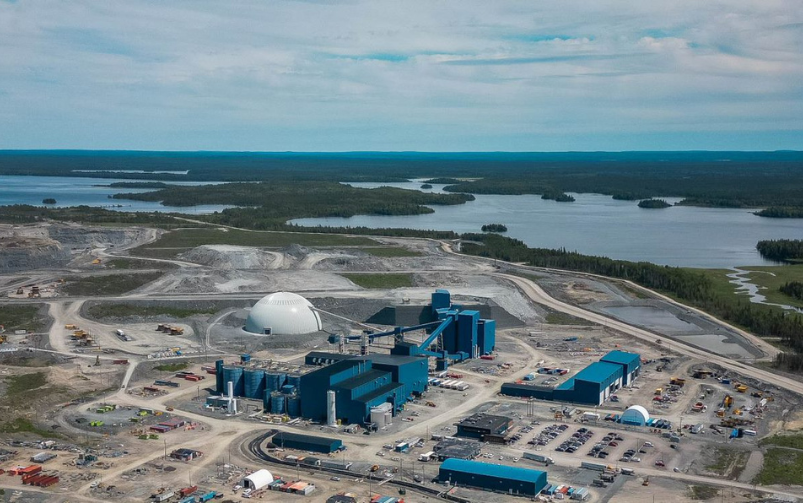According to the United States National Oceanic and Atmospheric Administration, algae blooms consist of cyanobacteria, which are often a blue-green colour, and can produce toxins that pose a risk to human and animal health and impact communities that depend on Lake Erie. Courtesy of the European Space Agency
Researchers at Brock University in St. Catharines, Ontario, are studying how to extract copper from Lake Erie’s algae blooms. Vaughn Mangal, an assistant professor of chemistry, and Reem Mahamoud, a fourth-year chemistry student, have teamed up with Destiny Copper, a copper extraction company located in Thorold, Ontario, to conduct a year-long proof-of-concept project that involves conducting lab tests to evaluate just how much copper can be extracted from algae under controlled conditions.
Destiny Copper won a spot in the university’s BioLinc business incubator in 2020 for its research aimed at developing a method for extracting copper from small, otherwise unviable deposits by leaching it from crushed ore with water and chemicals, creating a copper sulfate solution. This solution, known as “blue juice,” is then treated to produce granular copper. This is one of the methods the team is using to extract copper from the algae blooms.
Copper accumulation in algae blooms
Mangal said in an interview with CIM Magazine that his inspiration for the project to extract copper from algae came from phytoremediation, the practice of using plants, fungi or algae to help restore polluted areas by removing contaminants from the environment. He said that algae blooms need to accumulate small amounts of nutrients for their growth, and copper ends up being one of these micronutrients.
“We are using the fact that algae will accumulate copper within their cells as a remediation strategy,” he said in a follow-up email to CIM Magazine. Once the blooms accumulate copper from the water into their cells, these blooms can be harvested, and the copper extracted for industrial use cases.
“Phytoremediation has been used for petroleum spills and other types of contaminants that have been exposed to the environment,” Mangal said. “This type of remediation is something different. Normally, it’s done with plants to uptake metals out of the soil, but we’re using algae as a form of phytoremediation to extract and pull up some of the copper [from water].”
An increase in nitrogen, potassium and phosphorus from increased agricultural and industrial activity around Lake Erie, along with warm temperatures, have contributed to the growth of algae blooms. This combination of high algae coverage, warm water and nutrient input made Lake Erie a good candidate location to harness algae, Mangal said in an email to CIM Magazine.
“Our group has looked at copper concentrations in the soils and water of the nearshore regions of Lake Erie in Port Colborne, Ontario,” he wrote. “Dissolved copper concentrations were higher than other drains in the region and could represent a source of discharged copper into Lake Erie.”
According to the United States Environmental Protection Agency, since Lake Erie is the warmest and shallowest of the Great Lakes, it is more susceptible to algae blooms.
Mangal told CIM Magazine that he and Mahamoud are collecting algae samples to extract copper that otherwise would have been lost or recycled within the Great Lakes.
Over the summer, the researchers collected Cladophora algae samples at multiple spots along the nearshore regions of the lake near Port Colborne, which were incubated for nearly a week before Mahamoud experimented using various acids to break them down.
Innovative extraction methods
The team is trialing three or four chemical and physical digestion methods to see which method could work best to extract copper from algae cells, before placing the solution into an extraction chamber at Destiny Copper so that they can maximize how much copper is being extracted from algae blooms. Mahamoud explained that there is still a lot of method development and troubleshooting needed to determine the best way to maximize how much copper can be removed from algae blooms.
Mangal noted that redox chemistry is used at Destiny Copper to extract copper from the blooms. “It’s quite a simple, low energy process that just uses some core chemistry principles to get this copper out of a contaminated solution,” he wrote.
He said that in controlled systems, the teams have observed up to 80 per cent removal of copper from the surrounding solution, indicating that algae accumulate most of the copper entering aquatic systems, particularly in the summer when algae blooms become more frequent.
Early days
While this research could prove useful to the mining industry by opening doors to the extraction of different types of metals from algae blooms, Mangal said that the research is in its early stages and only small amounts of copper have been extracted from the blooms so far, so it will take more time and experimentation before algae can be looked at as a reliable copper source. If it becomes viable, the process could be extrapolated to other base metals, such as nickel and zinc.
Mangal said that the research could be useful for the mining industry by exploring alternative sources of trace metal and resource extraction in the environment.
“Getting the resources, whether it’s through federal or provincial incentives, to initiate these cleanup efforts, that would probably be the biggest bottleneck to actually getting this commercialized or more readily used,” he wrote.
Special equipment from the university’s Validation, Prototyping and Manufacturing Institute was used by the team for these experiments, which concluded in September, with research analysis and results expected to come next year.
The equipment includes an inductively coupled plasma mass spectrometer, which helps with the trace quantification of copper. In addition to this, the team also has access to scanning electron microscopy that can help visualize how the algae are internalizing the copper.
The research for this project will continue if the proof-of-concept project continues to yield successful results, with the team planning to return to Lake Erie next summer to harvest more algae samples and troubleshoot the methods they developed in the lab to see if they are viable.




